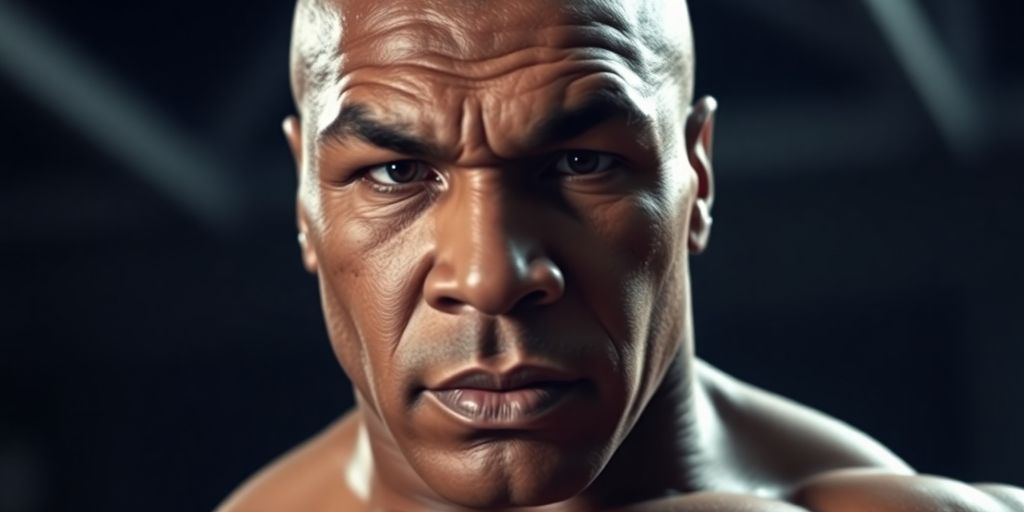Mike Tyson, a name synonymous with boxing greatness, has often been the subject of debate when it comes to his height. Known for his ferocious fighting style, many fans and analysts have speculated about how his stature played a role in his success inside the ring. This article aims to explore Mike Tyson’s height, its implications in the sport, and how it compares to other boxers, all while considering the cultural significance of his physical legacy.
Key Takeaways
- Mike Tyson is officially listed at 5’10” (177.8 cm), but there are claims of variations in his height.
- Height can impact a boxer’s reach and fighting style, which was crucial for Tyson’s aggressive approach.
- Tyson’s body composition and muscle mass contributed to his fighting effectiveness, regardless of his height.
- Fan perceptions often exaggerate or underestimate a boxer’s height based on their fighting presence in the ring.
- As Tyson ages, there are discussions about potential height loss, but current evidence suggests he may have maintained most of his height.
Mike Tyson’s Height Measurements
Official Height Listing
When it comes to Mike Tyson’s height, things get a little complicated. The official listing often states him as 5 feet 10 inches (178 cm). However, Tyson himself has made various claims over the years, sometimes even calling himself a "dwarf" in comparison to taller opponents. It’s not unusual for athletes to have their heights slightly exaggerated, especially in boxing, to create a more imposing image. This makes pinpointing his exact height a bit of a challenge.
Claims of Height Variations
Mike Tyson has given different figures for his height at different times. In one instance, he mentioned measuring himself at 5’10". He also stated he was 5’10 1/2". These variations contribute to the ongoing debate about his true height. It’s possible that these differences are due to factors like posture, time of day, or even just a bit of playful exaggeration. It’s also worth noting that height can decrease slightly with age. It’s interesting to see how these claims stack up against observations and comparisons with other individuals.
Comparative Height Analysis
Comparing Tyson’s height to other well-known figures can provide a clearer picture. For example, photos of Tyson next to other boxers and celebrities offer visual clues. While some observers suggest he might be a flat 5’10", others argue he could have been closer to 5’10.5" at his peak. These comparisons often rely on visual estimations, which can be subjective. However, they do add another layer to the discussion. For instance, Tyson Fury’s impact in boxing is notable, even though he doesn’t have the typical heavyweight build.
It’s important to remember that height is just one aspect of an athlete’s overall physical profile. Factors like reach, weight, and muscle mass also play significant roles in their performance. In Tyson’s case, his explosive power and fighting style often overshadowed any perceived height disadvantage.
Here’s a quick look at some height comparisons:
- Evander Holyfield: 6ft 1 ¼ (186 cm)
- Larry Holmes: 6ft 3 (191 cm)
- Carl Froch: 6ft 0 (183 cm)
- Barry McGuigan: 5ft 5 ½ (166 cm)
The Impact of Height in Boxing

Height vs. Reach
Height in boxing is more than just a number; it’s a strategic asset. Taller fighters often have a reach advantage, allowing them to control the distance and dictate the pace of a fight. A longer reach means a fighter can land punches from further away, making it harder for their opponent to get inside and land their own shots. However, height alone isn’t enough. A shorter fighter with a longer reach can negate the height advantage. It’s all about how effectively a fighter uses their physical attributes.
Psychological Effects of Height
Height can play a significant psychological role in boxing. A taller fighter might feel more dominant, while a shorter fighter might feel intimidated. This psychological edge can influence a fighter’s confidence and aggression. However, experienced fighters know that mental toughness is just as important as physical size. Overconfidence can lead to mistakes, and a skilled shorter fighter can exploit a taller opponent’s weaknesses. It’s a game of perception and mental fortitude as much as physical prowess. The backward straight punches can be more effective if the fighter is confident.
Historical Examples of Height Disparity
Throughout boxing history, there have been many memorable fights where height disparity played a significant role. Consider these examples:
- David and Goliath matchups: Where a smaller, quicker fighter defeats a larger, slower opponent.
- Dominant reigns of tall champions: Fighters who used their height and reach to control the division for years.
- Fights where height was neutralized: Where skill and strategy overcame a significant height disadvantage.
Height is just one piece of the puzzle. Factors like speed, power, technique, and ring intelligence are equally important. A fighter’s ability to adapt and exploit their opponent’s weaknesses often determines the outcome, regardless of height. It’s about maximizing your strengths and minimizing your weaknesses, no matter your size.
Mike Tyson’s Physical Attributes
Body Composition
Mike Tyson’s body composition was a key factor in his boxing success. He wasn’t the tallest heavyweight, but his build was something else. He carried a lot of muscle for his height, making him incredibly strong and explosive. During his prime, Tyson’s weight usually hovered around 215-220 pounds, which was impressive considering his height. This combination of weight and power made him a formidable opponent.
Muscle Mass and Strength
Tyson’s muscle mass and strength were exceptional. He focused on explosive power rather than just size. His training regimen included a lot of calisthenics, weightlifting, and neck exercises to build up his strength. This is what allowed him to generate so much power in his punches. He was known for his incredible punching power, and that came from a combination of technique and raw strength. His neck strength was also legendary, helping him absorb punches that would knock out other fighters. You can see how his boxing legacy was built on this.
Proportionality and Appearance
Tyson’s proportionality played a role in his fighting style. He had a shorter reach than many of his opponents, but he used his compact frame to his advantage. He would get inside, using his head movement and footwork to avoid punches, and then unleash devastating combinations. His appearance was intimidating, with a powerful build and intense stare. He looked like a force to be reckoned with, and that definitely played a psychological role in his fights.
Tyson’s physical attributes were a unique combination of genetics and hard work. He wasn’t the tallest or the rangiest fighter, but he maximized his strengths to become one of the most dominant heavyweight champions of all time. His power, speed, and agility made him a nightmare for any opponent.
Height Perception in the Ring
Visual Illusions of Height
In the boxing ring, what you see isn’t always what you get. Lighting, camera angles, and even the fighters’ stances can play tricks on the eye. A shorter fighter might appear taller if they’re standing closer to the camera, or if their opponent is slouching. It’s all about creating a perception, and sometimes, that perception can be misleading. These visual tricks can influence how judges and even opponents perceive a fighter’s presence and potential threat.
Height Comparisons with Opponents
Height comparisons are a constant topic of discussion before, during, and after fights. Fans and analysts love to dissect how a fighter’s height stacks up against their opponent. This isn’t just about bragging rights; it’s about understanding potential advantages and disadvantages. A taller fighter might have an easier time landing jabs from a distance, while a shorter fighter might excel at getting inside and delivering powerful body shots. When Tony Tucker faced Tyson, the height difference was a talking point, influencing expectations and strategies.
Fan Perceptions and Misconceptions
Fans often have preconceived notions about height in boxing. There’s a common belief that taller fighters automatically have an advantage, but that’s not always the case. Mike Tyson, despite being shorter than many of his opponents, dominated the heavyweight division for years. This shows that skill, speed, and power can often outweigh height. However, the perception persists, and it can influence how fans view a fight and the fighters involved.
It’s interesting how much emphasis is placed on height, even when other factors are more important. A fighter’s heart, determination, and training can often make up for a lack of height. Yet, the visual impact of a taller fighter can be intimidating, and that psychological effect shouldn’t be underestimated.
Here are some common misconceptions about height in boxing:
- Taller fighters always win.
- Shorter fighters are always at a disadvantage.
- Height is the most important physical attribute.
Tyson’s Height Over the Years
Peak Height vs. Current Height
It’s interesting to consider how Mike Tyson’s height might have changed over time. When he was in his prime, there were many claims that he was around 5’10" or even 5’10.5". Some people even thought he was closer to 5’11" when measured in shoes. However, as people age, it’s common to experience some height loss.
Factors Affecting Height Loss
Several factors can contribute to height loss as people get older. These include:
- Spinal compression: The discs in our spine can compress over time, leading to a decrease in height.
- Muscle loss: As we age, we tend to lose muscle mass, which can affect posture and overall height.
- Bone density: A decrease in bone density can also contribute to height loss.
It’s worth noting that height loss is a natural part of aging and can vary from person to person. While some individuals may experience a significant decrease in height, others may only lose a small amount.
Aging and Athletic Performance
Aging can affect athletic performance in various ways. While height loss itself may not have a direct impact, other age-related changes can play a role. For example, a decrease in muscle mass and bone density can affect strength and agility. It’s important for athletes to adapt their training and lifestyle as they age to maintain their performance. It’s possible that Tyson’s physical attributes have changed over the years.
Cultural Significance of Tyson’s Height

Height in Sports Culture
Height is a big deal in sports, no doubt. In boxing, it’s often seen as an advantage, but Mike Tyson kind of flipped that script. He wasn’t the tallest guy, especially for a heavyweight, but he still dominated. This challenges the idea that you need to be a giant to succeed. It’s more about skill, power, and strategy. Tyson’s success showed that technique and aggression can overcome a height disadvantage. It made people rethink what it takes to be a champion.
Media Representation of Tyson
The media played a huge role in shaping how we see Tyson. They often focused on his intensity and raw power, sometimes downplaying his height. He was portrayed as this unstoppable force, a kind of David versus Goliath figure in some matchups. This narrative helped build his legend. It made him more relatable to some fans, proving that you don’t have to be physically imposing to be a force to be reckoned with. The media’s focus on his persona overshadowed his actual height, creating a larger-than-life image.
Influence on Boxing Legacy
Tyson’s impact on boxing is undeniable. He changed the way smaller fighters are perceived. He proved that a shorter, stockier fighter could beat taller opponents with the right approach. This influenced training styles and strategies for many boxers who came after him. He showed that speed, agility, and inside fighting skills are just as important as reach and height. Tyson’s legacy is one of defying expectations and proving that heart and skill can triumph over physical limitations. He left a lasting mark on the sport, inspiring a new generation of fighters to embrace their strengths, regardless of their size.
Tyson’s success wasn’t just about winning fights; it was about changing perceptions. He showed that boxing isn’t just about physical attributes; it’s about mental toughness, strategy, and the will to win. His influence extends beyond the ring, inspiring people to overcome challenges and defy expectations in all aspects of life.
Here are some ways Tyson influenced boxing:
- Emphasized the importance of speed and agility.
- Popularized the peek-a-boo style.
- Inspired smaller fighters to believe in themselves.
Comparative Analysis with Other Boxers
Height of Notable Heavyweights
When you look at boxing history, especially the heavyweight division, height is just one piece of the puzzle. It’s interesting to see how different fighters with varying heights have found success. For example, some of the taller guys like Lennox Lewis (6’5") used their height and reach to keep opponents at bay. Then you have someone like Wladimir Klitschko (6’6") who also used his size to his advantage. But then you have shorter fighters who were also successful.
Tyson vs. Contemporary Fighters
Mike Tyson, often listed around 5’10", was shorter than many of his contemporaries. This meant he had to get inside, which was part of his exciting style. Comparing him to someone like Evander Holyfield Holyfield vs Tyson II, who was a few inches taller, shows how different strategies come into play. Tyson’s explosiveness and power helped him overcome the height disadvantage. It’s a classic case of different styles making for exciting fights.
Height Trends in Boxing
Boxing has seen trends come and go. There was a time when taller, rangier fighters seemed to dominate. Now, you see a mix of styles and sizes. It’s less about height alone and more about how a fighter uses their attributes.
Here are some things to consider:
- The average height of heavyweights seems to be increasing slightly over time.
- Shorter fighters often rely on speed and power.
- Reach is often more important than height.
It’s easy to get caught up in stats, but boxing is about more than just numbers. It’s about heart, skill, and strategy. A fighter’s height is just one factor among many that contribute to their success. It’s how they use what they have that really matters.
Final Thoughts on Mike Tyson’s Height
So, when it comes to Mike Tyson’s height, it seems like there’s a lot of chatter. Officially, he’s listed at 5 feet 10 inches, but some folks argue he might have been a bit taller in his prime. It’s funny how height can be such a big deal in boxing, especially when you’re up against giants. Tyson himself joked about being a ‘dwarf’ compared to his opponents, which just shows his confidence. Whether he’s 5’10 or a smidge more, his presence in the ring was massive. In the end, height is just a number, and Tyson proved that skill and determination matter way more.
Frequently Asked Questions
How tall is Mike Tyson?
Mike Tyson is officially listed as 5 feet 10 inches tall, which is about 177.8 centimeters.
Has Mike Tyson’s height changed over the years?
Some people believe that Mike Tyson may have lost a little height as he has aged, but many think he is still around the same height.
What do other boxers say about Tyson’s height?
Some boxers who have fought Tyson, like Lennox Lewis, have said that Tyson looks shorter compared to taller fighters.
How does Tyson’s height compare to other famous boxers?
Many heavyweight boxers are taller than Tyson. For example, Evander Holyfield is about 6 feet 1 inch tall.
Does height matter in boxing?
Yes, height can affect a boxer’s reach and fighting style, but skill and strength are also very important.
Why does Tyson call himself a ‘dwarf’?
Tyson jokingly refers to himself as a ‘dwarf’ because he feels short compared to taller fighters, even though he is taller than the average person.













